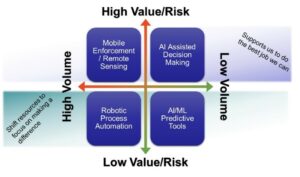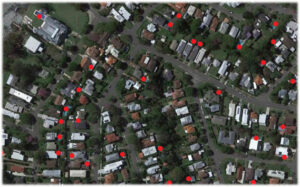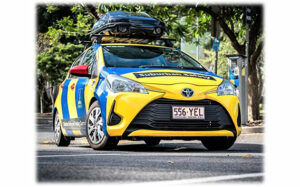Modern-day blacksmithing: equipping our people with RegTech tools
6 October 2021
● News and media
This guest editorial was written for the ANZSOG/National Regulators Community of practice monthly newsletter, highlighting new additions to the Regulation Policy and Practice collection on APO. The RP&P collection brings together a range of practical resources from national, local and state/territory governments, regulatory agencies and external institutions conducting monitoring, inquiries and reviews. You can receive this newsletter by joining the ANZSOG/National Regulators Community of Practice (membership is free) or subscribe to the newsletter directly.
By Anne Lenz
The role of a blacksmith
In the days before mass production and automated fabrication, craftspeople and professionals needed tools just like they do today. While the masons built castles and the farmers fed nations, they all relied on having the right tools to do their jobs and this meant everybody needed the blacksmith.
With the rise of industry, the need for bespoke tools and the skills to repair them did not go away. Machines needed custom parts and tools became specialised for specific tasks; industries needed the blacksmith.
As times have changed and technology has developed, the concept of a tool has changed too. While the tools of the past magnified the speed and quality at which a crafter could craft or a farmer could farm, we have tools today that enhance the speed and quality at which deciders decide. The question is: what happened to the blacksmith? We could now say that the blacksmith has been replaced by the tech-smith.
The tech-smiths and their tools
The tools of today have many labels but some of the better known are:
Artificial Intelligence,
Machine Learning,
Robotic Process Automation,
Predictive Analytics,
Software Applications,
Internet of Things, and
anything beginning with a lowercase “i”.
Rather than armourers, farriers and weaponsmiths we now have software engineers, systems analysts, and business intelligence specialists. The master tech-smith has traded the hammer and anvil for code and hardware, but the general concept remains: if we want our people to be able to do the best job possible, they need the tools that are well-made, fit for purpose and maintained and so we need the tech-smith.
How do you make technology work for you?
When asked how we make sure our staff have the best remote sensor information, the safest enforcement technology or the timeliest data-driven decisions, our answer is we invest in the skills and the capabilities required to build and maintain the tools.
This starts with funding a Systems and Analytics team to support our growth and to sustain our technology over time, but it doesn’t end there. It is important to support the investment in technological tools by championing their value and creating seats at the decision-making table. It’s not enough to only spend money on tools. To truly create value over time, the toolmakers need to be involved in setting the future direction.
What tools do we use?
While it might be an obvious statement, a key factor in understanding the tools regulators use is appreciating that there is a large variety of different tasks that are undertaken and so the tools may be just as varied. Regardless of whether we are equipping compliance officers or policymakers, there are two effects we want; to let our people focus on the important work and to support them to do the important jobs well. Figure 1 below describes one way of categorising regulatory tools along risk vs volume axis as viewed by the Compliance and Regulatory Services in Brisbane City Council.

Figure 1. Our tools and how we use them
The axis from left to right is the volume of work where high volume on the left describes activities that occur frequently, such as parking compliance patrols, and low volume on the right includes activities such as business planning and policy reviews.
The top to bottom axis on the other hand depicts how much community value is derived from each activity or how much risk is involved with each iteration. Low risk/value activities are those such as file administration while activities like identifying pools that have not received a safety certificate is much higher value and supports eliminating a serious safety risk.
Figure 1 above gives examples of the technology Compliance and Regulatory Services in Brisbane City Council uses that falls into each quadrant:
Machine Learning and AI Predictive Tools

Dangerous Dog Predictions and Parking Infringement Hotspot dashboards are tools that assist us by consuming historical data, evaluating criteria to figure out which criteria affected the outcome and then using that evaluated historical data to indicate when those same types of events will occur again.
Figure 2. Predictive Model Overlay
This technology doesn’t replace human decision making but rather enables the decision-makers to focus their efforts where it matters most.
While these tools aren’t perfect, they allow us to be more efficient in planning and resource allocation.
Robotic Process Automation

Robotic Process Automation is not AI – the robots cannot think for themselves but rather follow instructions very well. Maevis and Bebop (two of our bots) have been running successfully and have reliably automated thousands of transactions which means we have been able to focus our staff on higher value, customer-facing activities.
Artificial Intelligence (AI) assisted information gathering for decision making
Unlike predictive modelling, AI assisted decision-making applies Artificial Intelligence in ways that filter out noise; figuratively but also literally.
The general concept is to allow AI to review large amounts of information and for the AI to indicate to us where we should look. Figure 3 shows the output of one such tool that reviews very large sets of aerial photography to identify the location of pools in Brisbane.

Figure 3. AI Assisted Pool Identification
We also use AI to literally remove background noise regarding dog barking incidents – a common complaint to council. This uses AI to map the sound profile of a bark so that, instead of listening to hours of audio, the AI can tell us exactly when it thinks it has heard a dog bark.
AI has its place to gather data for a decision, but it is important to remember it is a tool of our trade. It doesn’t make decisions for us. It helps focus our attention and saves time. It doesn’t exercise judgement and discretion in a regulatory context.
Mobile Enforcement Technology and Remote Sensing
These are the big-ticket items when it comes to regulatory technology in the field that changes the way we work. This is, by far, the most expensive category but these types of tools support high volume and high value activities that deliver the largest return on investment, especially in terms of officer and public safety.
With roof-mounted cameras that recognise number plates and the AI to process images and recognise objects (such as signs), the Mobile Enforcement Technology vehicles enable wider coverage, in all weather, in a highly visible vehicle that also creates passive compliance (see Figure 4).

Figure 4. Mobile Enforcement Technology Vehicle
Like all other regulatory technology that is employed by Brisbane City Council, this does not replace a well-trained compliance officer but rather supports them to do their job more effectively and in a safer way. It captures images and applies rules to these images and then presents a package of information for an authorised officer to examine and then decide whether compliance action is required and if so, what action is appropriate in the circumstances.
What does the future look like?
Much like the past and the present, the future will be led by organisations that equip their people with the best tools. For Brisbane City Council, the future looks like:
More investment in Remote Sensing technologies that tell us about the health and safety of our city.
Expansion and continual improvement of Mobile Enforcement Vehicles to improve efficiency and safety for staff as they go about their duties and to increase data quality available to officers to assist with regulatory decision making (such as new camera configurations/angles)
Process automations that free up our people to apply their skills to more valuable activities.
Artificial Intelligence assisted information gathering to support decision making, focusing our resources on the services that matter most for the people of Brisbane.
Regardless of the specific business problems that will arise, the future will require us all to continue to value and support the tech-smiths that create and maintain the tools we need to do our jobs well. Either that or we may find ourselves to be like masons without chisels; painfully bashing our heads against rocks.
Anne Lenz has spent 17 years with the State environmental regulator in Queensland and now leads the Compliance and Regulatory Services branch at Brisbane City Council. She has been responsible for everything from underground coal gasification policy, management of abandoned sites to environmental regulation of the coal seam gas sector, and more recently for the regulation of a range of functions from built environment, environmental health and natural environment, to animal management, amenity and parking in Australia’s largest local government.
